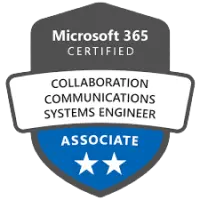Skaffa nya IT-kunskaper, bli certifierad och lyft din IT-karriär till nya höjder utan att spränga banken!
Unlimited Training - IT kurser och certifieringar gjort enkla och otroligt billiga. Få tillgång till 60+ LIVE-kurser för mindre än priset för en kurs.











course: Microsoft 365 Certified Collaboration Communications Systems Engineer (MS-721)
Varighet: 4 days
Format: Virtual or Classroom


Översikt
Excel i samverkan och kommunikationssystem med vår specialiserade utbildning. Lär dig att designa, implementera och hantera Microsoft 365-kommunikationslösningar. Från röst- och videokonferenser till meddelandeplattformar, den här certifieringskursen täcker alla aspekter av samarbetssystemteknik. Med praktiska laborationer och expertledd instruktion får du de färdigheter som behövs för att klara MS-721-provet och bli certifierad som en samarbetskommunikationssystemingenjör. Registrera dig nu för att bli certifierad och avancera din karriär inom samarbetsteknik.
 instruktörsledd utbildning
instruktörsledd utbildning Practice test
Practice test Självstudiematerial
Självstudiematerial Personlig inlärningsplan
Personlig inlärningsplan Certifieringsgaranti
Certifieringsgaranti E-post, chatt och telefonsupport
E-post, chatt och telefonsupport









Vem raiktar sig kursen till?
MS-721-examen, även känd som "Microsoft Teams Certified Engineer Associate"-examen, utvärderar någon som är ansvarig för att hantera Microsoft Teams telefoner, möten och olika enheter. Provet mäter kandidatens förmåga att planera och konfigurera Teams-möten, hantera och felsöka Teams-rum och Microsoft Surface Hub-enheter, konfigurera Teams telefonsystemfunktioner, övervaka Teams samtalskvalitet och planera identitets- och åtkomsthantering för Teams-användare. Kandidater förväntas ha en grundläggande förståelse för nätverk, telekommunikation, audio/visuell och mötesrumsteknik samt identitets- och åtkomsthantering för att hantera och övervaka Teams telefon, möten och certifierade enheter med hjälp av olika verktyg.
Kursinnehåll
Förberedelse
På Readynez tillhandahåller vi många resurser och har erfarna experter inom området. Därför är vi också mycket framgångsrika med många nöjda kunder. Du kan därför tryggt gå din kurs hos oss. För att gå kursen Microsoft 365 Certified Collaboration Communications Systems Engineer krävs dock några förkunskaper.
Dessa förkunskaper ger dig den perfekta utgångspunkten för att gå kursen:
Möt några av de instruktörer du möter på din kurs. De är experter, passionerade inom sina områden och dedikerade till att hjälpa de som vill lära sig, utforska och bli framgångsrika i sina karriärer.

Jens har varit MCT i 20 år, och är auktoriserad Amazon Champion Instruktör med gedigen erfarenhet som Cloud Infrastructure Security Consultant och Penetration Tester.
Jens Gilges is a highly skilled professional with expertise in Azure, AWS, and Penetration Testing. With a remarkable 20-year tenure as a Microsoft Certified Trainer (MCT), Jens has honed his proficiency in various Microsoft technologies. Notably, he is not just a trainer but an industry leader, holding the prestigious title of AWS Champion Instructor.
Jens is dedicated to imparting his knowledge globally, delivering top-tier security and AWS training to clients across the world. His passion for these cloud platforms shines through in his engaging and informative sessions. Whether you're seeking insights into Azure's versatile capabilities, AWS's vast infrastructure, or the intricacies of Penetration Testing, Jens is your go-to expert.
With Jens at the helm, you can expect a comprehensive learning experience that combines years of expertise with a commitment to staying at the forefront of cloud technologies. Join him on a journey of continuous learning and explore the ever-evolving landscapes of Azure, AWS, and Penetration Testing.
FAQ
Certifiering av Certified Collaboration Communications Systems Engineer validerar expertis i att designa, implementera och hantera samarbetsoch kommunikationslösningar med hjälp av Microsofts teknologier. Den täcker olika aspekter av kommunikationssystem, inklusive röst, video, meddelanden och konferenser, och förbereder proffs för roller inom enhetlig kommunikation och samarbete.
Vår Certified Collaboration Communications Systems Engineer-kurs (MS-721) förbereder dig för att utmärka dig i roller som samarbetsoch kommunikationssystemtekniker. Förbered dig för provet och få certifiering som en samarbetskommunikationssystemingenjör med vårt specialiserade utbildningsprogram. Lär dig att designa och implementera kommunikationslösningar som förbättrar produktivitet och samarbete. Gå med oss och bli ledande inom kommunikationssystemteknik.
Även om det inte finns några obligatoriska förutsättningar för certifiering av Certified Collaboration Communications Systems Engineer, bör kandidater ha en god förståelse för Microsofts samarbetstekniker och praktisk erfarenhet av att implementera och hantera kommunikationslösningar. Bekantskap med Microsoft Teams, Skype för företag, Exchange Server och relaterade tekniker är fördelaktigt.
Kostnaden för MS-721-provet är cirka 142 €.
MS-721-provet täcker ämnen som att designa och distribuera Microsoft Teams, konfigurera Skype för företag, integrera kommunikationslösningar med Exchange Server, implementera röstoch videolösningar och hantera samarbetssäkerhet och efterlevnad. Den utvärderar kandidaternas förmåga att designa och hantera Microsofts samarbetsoch kommunikationsmiljöer effektivt.
Ja, certifieringen av Certified Collaboration Communications Systems Engineer är mycket värdefull för individer som gör karriärer inom enhetlig kommunikation, samarbete och företagskommunikationssystem som använder Microsoft-teknik. Det visar expertis i att designa, implementera och hantera Microsofts samarbetslösningar, förbättra karriärmöjligheter och intjäningspotential inom området.
Tiden det tar att bli certifierad Certified Collaboration Communications Systems Engineer varierar beroende på individuell erfarenhet, studievanor och engagemang. Vanligtvis tillbringar kandidater flera veckor till några månader med att förbereda sig för provet genom att själv studera, delta i utbildningar och få praktisk erfarenhet av Microsofts samarbetsteknik.
Ja, Microsoft erbjuder online-kontrollerade alternativ för MS-721-provet, vilket gör att kandidater kan göra provet på distans från sitt hem eller kontor. Se till att din dator uppfyller de tekniska kraven för proctoring online och följ examensregistreringsprocessen som beskrivs av Microsoft för examensleverans online.
Svårigheten att klara MS-721-provet beror på individuell kunskap, erfarenhet och förberedelser. Kandidater med en gedigen förståelse för Microsofts samarbetstekniker, praktisk erfarenhet av driftsättning och hantering och noggranna provförberedelser är mer benägna att lyckas med att klara provet.
Godkänt resultat för MS-721 är vanligtvis runt 700 av 1000.
För att bibehålla certifieringen av Certified Collaboration Communications Systems Engineer måste du slutföra nödvändiga Microsoft Learning-aktiviteter eller prov inom certifieringens giltighetsperiod. Håll dig uppdaterad med de senaste framstegen inom Microsofts samarbetstekniker, delta i relevant utbildning och förnya din certifiering innan den löper ut för att visa pågående expertis inom samarbetsoch kommunikationslösningar.
Lönepotential efter att ha erhållit certifieringen av Certified Collaboration Communications Systems Engineer varierar baserat på faktorer som plats, bransch, erfarenhet och jobbroll. Proffs med expertis inom Microsofts samarbetstekniker har vanligtvis konkurrenskraftiga löner, och intjäningspotentialen ökar med ytterligare erfarenhet och expertis inom enhetlig kommunikation och samarbete.
Recensioner

Readynez är den bästa utbildningsleverantören jag har använt på många år. Deras kundservice är förstklassig, priserna är mycket konkurrenskraftiga och instruktörerna är excellent.

Lätt att delta över Teams och en utmärkt instruktör gav mig stort värde för den tid jag investerade.
Varför betala mer?
Varför nöja sig med bara en certifieringskurs när du kan delta på ALLA certifieringskurser till ett pris som är lägre än priset för en kurs?

Ett perfekt sätt för oss att utveckla de kompetenser vi behöver för att bli framgångsrika
![]() Kasper Meyer Christensen
Kasper Meyer Christensen
Verksamheter som använder Unlimited Training sparar minst 50% på sin utbildning och certifiering - och många upp till 80%
Deltagare med Unlimited Training licens genomför i genomsnitt 2,4 kurser per år

För ett pris som är lägre än priset för en kurs

Bara billigare och mer flexibelt

Det enklaste, billigaste och mest flexibla sättet att bli certifierad på

Deltag på så många kurser du vill - inga begränsningar!

Vi betalar tillbaka om kostnaden för licensen överstiger värdet på din utbildning

Interagera 1-till-1 med 50+ erfarna instruktörer

